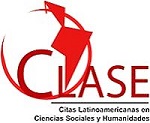Modelo Fractal empresa orientada para o projeto para redes de pequenas e médias empresas
Palavras-chave:
empresa fractal, modelo de negocios integrado, redes de PME, projectosResumo
Pequenas e médias empresas formar redes entre eles respondem a pressões concorrenciais. E aumentar a sua capacidade de reagir e se adaptar às mudanças no seu ambiente, o foco em suas competências essenciais, aumentar a disponibilidade de recursos e obter economias de escala. Para alcançar os benefícios destas parcerias é necessário modelo de empresa integrada que define papéis, responsabilidades, funções, objetivos e relações entre os atores. O objetivo deste trabalho é propor um modelo teórico dos projetos da empresa fractal-based para a integração de empresas virtuais e temporários. A implementação bem sucedida do modelo reside no estabelecimento de relações cliente-servidor entre gerentes de projeto. Para ilustrar este modelo e suas propriedades um exemplo hipotético envolvendo empresas farmacêuticas é usado.Métricas do artigo
Resumo: 471 PDF (Español (España)): 787Referências
BASOLE, Rahul y ROUSE, William, et al. (2011). Models of Complex Enterprise Networks. En: Journal of Enterprise Transformation Vol. 1 N° 3. Cambridge: MIT. Pp. 208-230.
BEER, Stafford. (1979). The heart of enterprise. Chichester: Wiley.
BEER, Stafford. (1984). The VSM- it provenance, development, methodology and pathology. En: Journal of the Operational Research Society N° 35. Londres: Springer. Pp. 7-25.
BIDER, Ilia, PERJOUS, Erick y ELIAS, Mturi. (2012). Untangling the dynamic structure of an enterprise by applying a fractal approach to business process. En: Proceeding of 5th IFIP WG 8.1 Working Conference. Rostock (Ale.): PoEM. Pp. 61-75.
CANAVESIO, Mercedes y MARTINEZ, Ernesto. (2007). Enterprise modeling of a project-oriented fractal company for SMEs networking. En: Computers in Industry N° 58. Amsterdam: Elsevier. Pp. 794-813.
ELMARAGHY, Hoda. (2009). The cognitive factory. En: Changeable and reconfigurable manufacturing systems. London: Springer. Pp. 1015-1024.
FISCHER, Klaus. (1999). Agent-based design of holonic manufacturing systems. En: Robotics and Autonomous Systems N° 27. Amsterdam: Elsevier., Pp. 3-13.
HOVERSTADT, Patrick, BOWLING, Diane. (2002). Modeling Organizations using the viable system model. En: Royal Academy of Engineering. Madrid: Systems Engineering Workshop. Pp. 1-14.
HOVERSTADT, Patrick. (2008). The fractal organization: Creating sustainable organization with the viable system model. Hoboken (E.U.A): John Wiley & Son.
HAUNG, Biqing y GOU, Hongmei. Et al. (2002), A framework for virtual enterprise control with the holonic manufacturing paradigm. En: Computers in Industry N° 49. Manchester: University of Manchester. Pp. 299-310.
KOUBARAKIS, Manalis y PLEXOUSAKIS, Dimitris. (2002). A formal framework for business process modeling and design. En: Information Systems Vol. 27 N° 5. Amsterdam: Elsevier. Pp. 299-319.
MANDELBROT, Benoit. (1978). Fractal: Form, chance, and dimension. New York: W.F. Freeman & Company.
MOORE, Samuel y MANRING, Susan. (2009). Strategy development in small and medium sized enterprises for sustainability and increased value creation. En: Journal of Cleaner Production Vol. 17 N° 2. Amsterdam: Elsevier. Pp. 276-282.
OKINO, Norio. (1989) Bionic manufacturing systems - Modelon-based approach. En: Proceeding of the CAM-I 18th Annual International Conference. New Orleans (E.U.A). Pp. 485-492.
OKINO, Norio. (1992). A prototyping of bionic manufacturing systems. En: Proceeding of the International Conference on Object-Oriented Manufacturing Systems. Calgary. Pp. 297-302.
OSTERLE, Hubert, FLEISCH, Elgar y ALT, Rainer. (2000). Business networking: shaping enterprise relationships on the internet. Berlin: Springer-Verlag.
PISANO, Gary. (1997). The development factory. Boston: Harvard Business School Press.
RAMANATHAN, Jay. (2005). Fractal architecture for the adaptive complex enterprise. En: Communications of the ACM N° 48. New York: ACM. Pp. 51-57.
RESE, Alexandra y BAIER, Daniel. (2011). Success factors for innovation management in networks of small and medium enterprises. En: R&D Management Vol. 41 N°2. Hoboken (E.U.A): John Wiley & Son. Pp 138-155.
RYU, Kwangyael, SON, Youngjun y JUNG, Mooyoung. (2003). Modeling and specifications of dynamic agents in fractal manufacturing systems. En: Computers in Industry Vol. 52 N°2. Amsterdam: Elsevier. Pp. 161-182.
SANDKUHL, Kurt y KIRIKOVA, Marite. (2011). Analyzing enterprise models from a fractal organization perspective – Potential and Limitations. En: Chapter in the Practice of Enterprise Modeling Vol. 92. Londres: Springer. Pp. 193-207.
SIHN, Wilfied. (2002). Fractal business in an e-business world. The 8th. International Conference on Concurrent Enterprising. Rome. Pp.17-19.
THARUMARAJAH, Anbalavanar. (2003). From fractals and bionics to holonics. En: Chapter Agent-based manufacturing (Ed. S.M. Deen). Berlin Heidelberg: Springer. Pp. 11-30.
VAN BRUSSEL, Hendrik y WYNS, Jo, Et al (1998). Reference architecture for holonic manufacturing systems PROSA. En: Computers in Industry Vol. 37 N° 3. Amsterdam: Elsevier. Pp. 255-274.
VALCKENAERS, Paul y VAN BRUSSEL, Hendrik, Et al. (1998). Designing holonic manufacturing systems. En: Robotic and Computers-Integrated manufacturing Vol. 14 N° 5. Amsterdam: Elsevier. Pp. 455-465.
WARNECKE, Hans-Jurgen. (1993). The fractal company: a revolution in corporate culture. Berlin: Springer-Verlag.
WESENBERG, Harald. (2011). Enterprise modeling in an agile world. En: practice of enterprise model. Heidelberg: Springer Berlin. Pp 126-130.





















